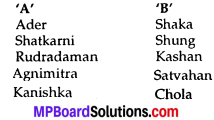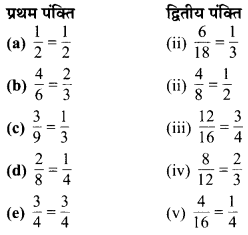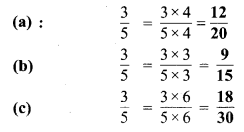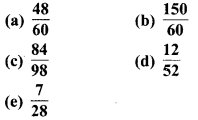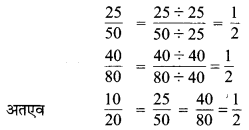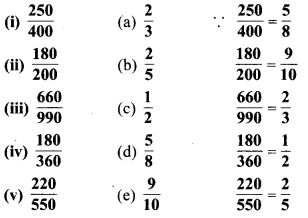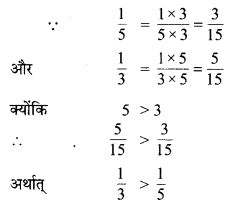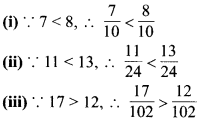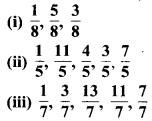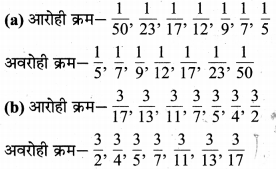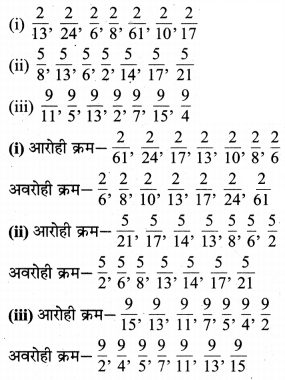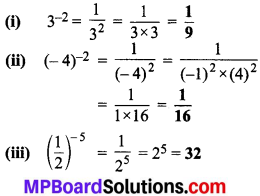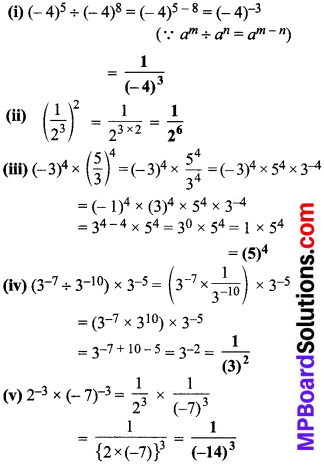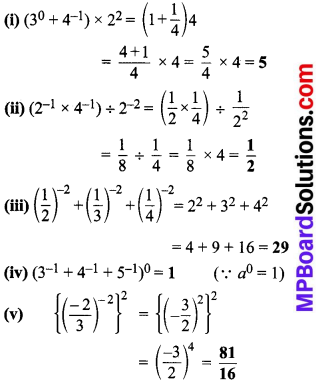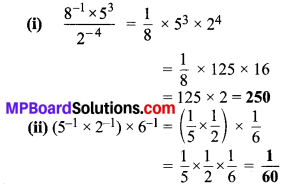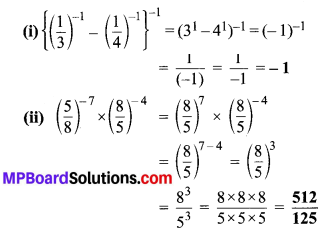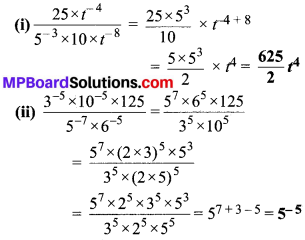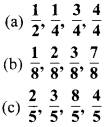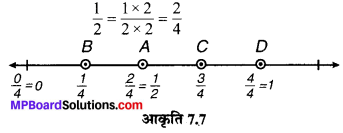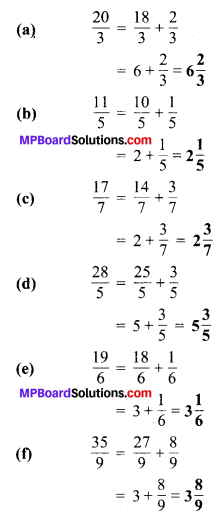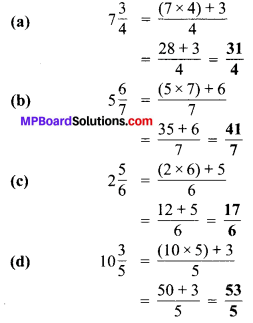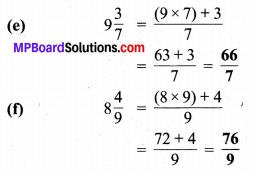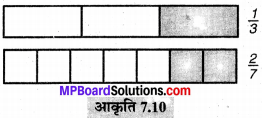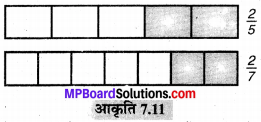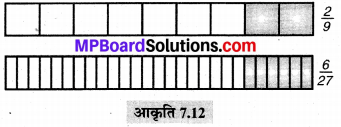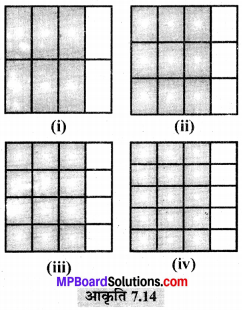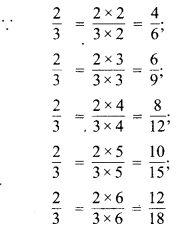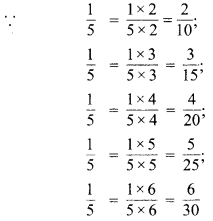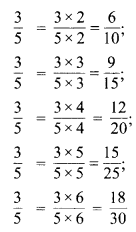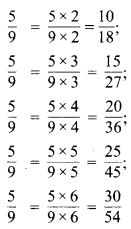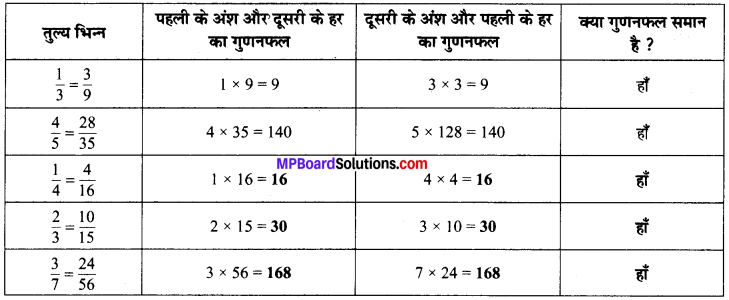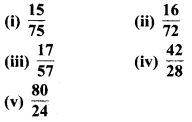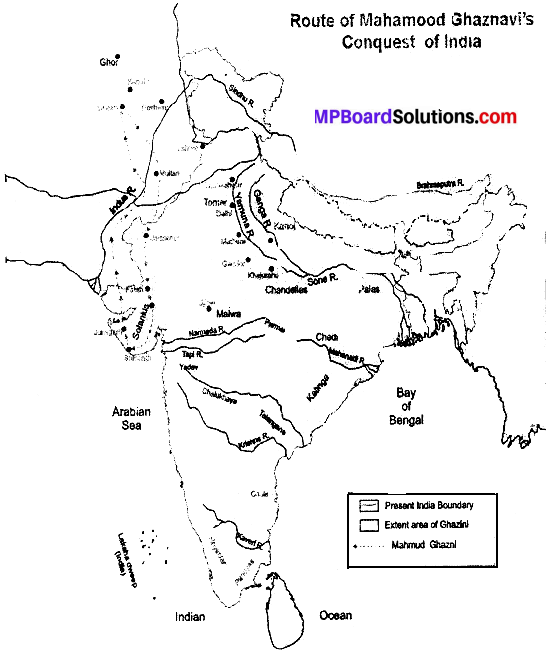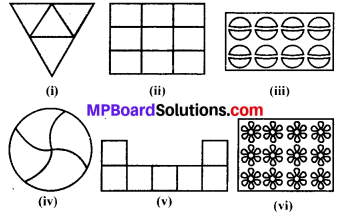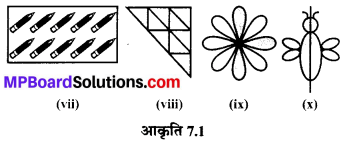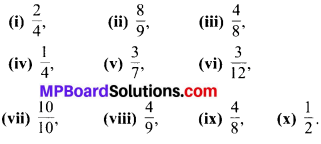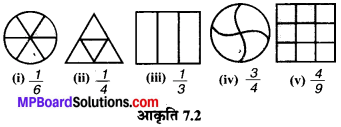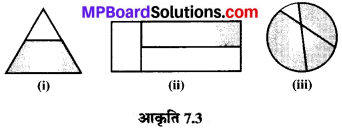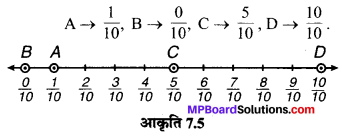MP Board Class 7th Sanskrit व्याकरण-खण्डः
1. शब्दरूपाणि
(क) संज्ञा शब्द रूप
अकारान्त (पुल्लिङ्ग) राम :

अनुकरण :
राम के समान ही बालक, गज, वानर, सूर्य, चन्द्र, नृप आदि सभी अकारान्त पदों के रूप चलेंगे।
![]()
इकारान्त (पुल्लिङ्ग) हरि :
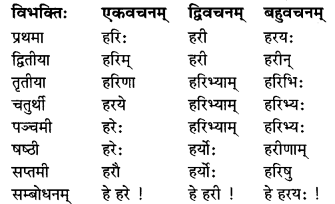
अनुकरण :
हरि के समान ही मुनि, गिरि, रवि, कपि, कवि, निधि, मणि, ऋषि आदि शब्दों के रूप चलेंगे।
अकारान्त (स्त्रीलिङ्ग) रमा (लक्ष्मी) :
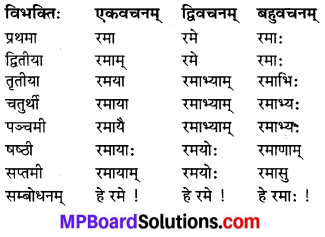
अनुकरण :
रमा के समान ही लता, माया, वाटिका, बालिका, पाठशाला, विद्या, वसुन्धरा आदि स्त्रीलिंग शब्दों के रूप चलेंगे।
उकारान्तः (पुल्लिङ्ग) “भानु” शब्द :
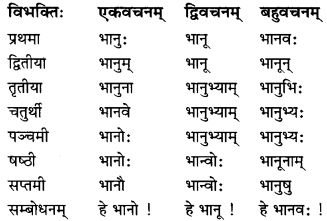
अनुकरण :
गुरु, तरु, शिशु, साधु इत्यादयः।
इकारान्त स्त्रीलिङ्ग “मति” शब्द :
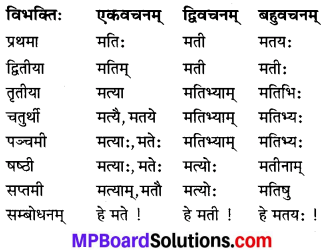
अनुकरण :
बुद्धि, गति, रात्रि इत्यादयः।
![]()
ईकारान्तः स्त्रीलिङ्गः “लेखनी” शब्दः
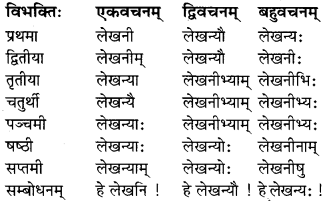
अनुकरण :
जननी, नदी, द्रोणी, गौरी इत्यादयः।
उकारान्तः स्त्रीलिङ्ग “धेनु” शब्दः
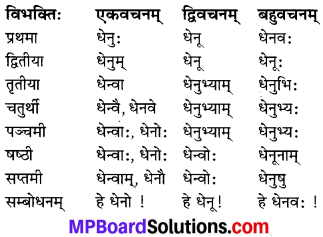
अनुकरण :
रेणु, रज्जु इत्यादयः।
इकारात नपुंसकलिङ्ग “वारि” शब्दः
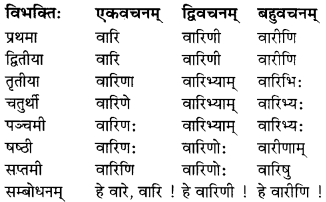
उकारान्तः नपुंसकलिङ्ग “मधु” शब्दः
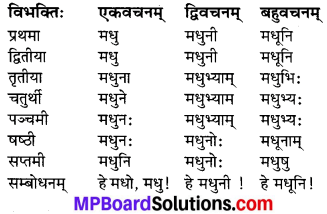
(ख) सर्वनाम शब्द रूप
दकारान्तः पुल्लिङ्ग “एतद्” (यह) शब्दः
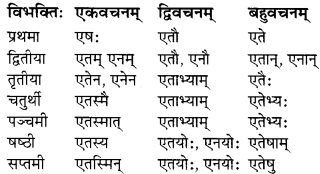
दकारान्तः स्त्रीलिङ्ग “एतद्” (यह) शब्दः
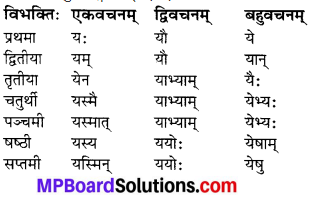
![]()
दकारान्तः नपुंसकलिङ्ग “एतद्” (यह) शब्दः

तृतीया से सप्तमी तक पुल्लिङ्ग के समान रूप होते हैं।
दकारान्तः पुल्लिङ्ग “यद्” (जो) शब्दः

दकारान्तः स्त्रीलिङ्ग “यद्” (जो) शब्द :
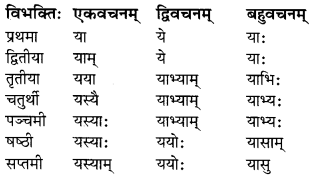
दकारान्तः नपुंसकलिङ्ग “यत्” (जो) शब्दः

तृतीया से सप्तमी तक पुल्लिङ्ग के समान रूप होते हैं।
पुल्लिङ्ग “सर्व’ (सब) शब्दः
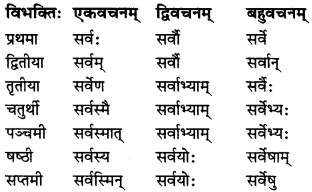
स्त्रीलिङ्ग “सर्व” (सब) शब्दः
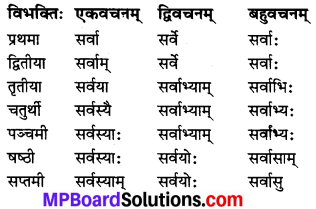
नपुंसकलिङ्ग “सर्व” (सब) शब्दः

तृतीया से सप्तमी विभक्ति एक पुल्लिङ्ग के समान रूप होते हैं। यद्-तद आदि सर्वनाम शब्दों में सम्बोधन नहीं होता है।
![]()
2. धातुरूपाणि
(क) परस्मैपदम्-
“पठ्’ (पढ़ना) धातुः लोट्लकारः (आज्ञार्थ)
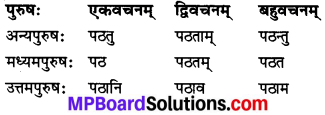
“पठ्’ (पढ़ना) धातुः विधिलिङ्गलकारः
(चाहिए अर्थ)

“गम्” (जाना) धातुः लोट्लकारः (आज्ञार्थ):
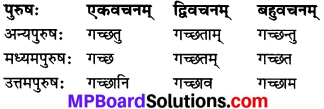
“गम्” (जाना) धातुः विधिलिङ्गलकारः
(चाहिए अर्थ)

(ख) आत्मनेपदम्-
“लभ्” (पाना) धातुः लट्लकारः (वर्तमानकाले):

![]()
“सेव” (सेवा करना) धातुः लट्लकारः
(वर्तमानकाले)

“वन्द्” (वन्दना करना) धातुः लट्लकारः
(वर्तमानकाले)
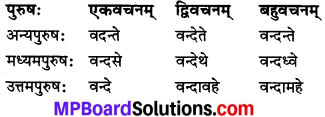
इसी तरह भाष्, यत्, रम्, सह, शिक्ष, रुच् (रोच्) वृत् (वत्), वृध् (वर्ध), शुभ् (शोभ) इत्यादि धातुरूप होते हैं।
3. संस्कृतसंख्या (११ तः २० पर्यन्तम्)
एकादश – ११ (बहुवचनं)
द्वादश – १२ (बहुवचनं)
त्रयोदश – १३ (बहुवचनं)
चतुर्दश – १४ (बहुवचनं)
पञ्चदश – १५ (बहुवचन)
षोडश – १६ (बहुवचन)
सप्तदश – १७ (बहुवचनं)
अष्टादश – १८ (बहुवचन)
नवदश, एकोनविंशतिः – १९ (बहुवचन)
विंशतिः – २० (बहुवचन)
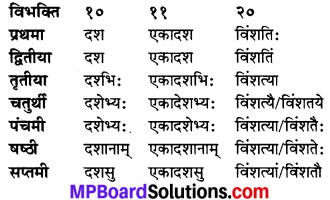
![]()
4. कारकपरिचयः
जिसका सम्बन्ध साक्षात् क्रिया के साथ होता है, उसे कारक कहते हैं। कारक छः होते हैं। सम्बन्ध को कारक नहीं माना गया है किन्तु विभक्तियाँ सात होती हैं।-
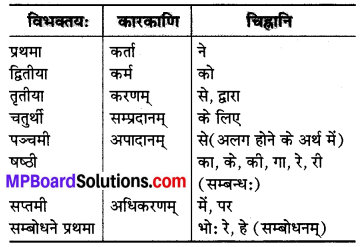
कतृकारकम् (प्रथमा विभक्तिः)
यथा-
रामः पठति।
श्यामः गच्छति।
कर्मकारकम् (द्वितीया विभक्तिः)
यथा-
रामः विद्यालयं गच्छति।
मोहनः पुस्तकं पठति।
करणकारकम् (तृतीया विभक्तिः)
यथा-
रामः बाणेन रावणं हन्ति।
सीता रामेण सह वनं गच्छति।
सम्प्रदानकारकम् (चतुर्थी विभक्तिः)
यथा-
राजा ब्राह्मणाय धनं ददाति।
गुरवे नमः।
![]()
अपादानकारकम् (पञ्चमी विभक्तिः)
यथा-
वृक्षात् पत्रं पतति।
हिमालयात् गङ्गा प्रभवति।
सम्बन्धः (षष्ठी विभक्तिः)
यथा-
रामः दशरथस्य पुत्रः अस्ति।
सीतायाः पतिः रामः अस्ति।
अधिकरणकारकम् (सप्तमी विभक्तिः)
यथा-
खगः वृक्षे निवसति।
मीन: नद्याम् अस्ति।
सम्बोधनम्-
यथा-
भो राम ! भवान् कुत्र गच्छति?
हे मोहन ! अत्र आगच्छ।
प्रस्तुत पद्य के आधार पर कारकों को स्मरण करना सरल है।-
कर्ता कर्म च करणं सम्प्रदानं तथैव च।
अपादानाधिकरणमित्याहुः कारकाणि षट्॥
5. सन्धिपरिचयः
(क) स्वरसन्धिः
स्वरसन्धि के भेद, प्रयोग और अभ्यास-
दीर्घसन्धिः
अ/आ + अ/आ = आ – हिम + आलयः = हिमालयः
इ/ई + इ/ई = ई – रवि + इन्द्रः = रवीन्द्रः
उ/ऊ + उ/ऊ = ऊ – भानु + उदयः = भानूदयः
ऋ/ऋ + ऋ/ऋ = ऋ – पितृ + ऋणम्: = पितृणम्
![]()
गुणसन्धिः
अ/आ + इ/ई = ए – सुर + इन्द्रः = सुरेन्द्रः
अ/आ + उ/ऊ = ओ – महा + उत्सवः = महोत्सवः
अ/आ + ऋ/ऋ = अर् – देव + ऋषिः = देवर्षिः
अ/आ + लृ = अल् – तव + लृकारः = तवल्कारः
वृद्धिसन्धिः
अ/आ + ए/ऐ = ऐ – सदा + एव = सदैव
अ/आ + ए/ऐ = ऐ – अत्र + एव = अत्रैव
अ/आ + ओ/औ = औ – महा + ओषधिः= महौषधिः
अ/आ + ओ/औ = औ – महा + ओजस्वी= महौजस्वी
यण सन्धिः
यदि असमान स्वर आगे आता है, तो-
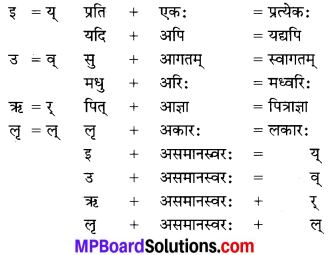
अयादि सन्धिः
यदि असमान स्वर आगे आता है, तो निम्न प्रकार से परिवर्तन होकर नया शब्द बन जाता है-
ए + असमानस्वरः = अय् – ने + अनम् = नयनम्
ऐ + असमानस्वरः = अय् – गै + अकः =गायक:
ओ + असमानस्वरः = अव् – पो + अनः = पवनः
औ + असमानस्वरः = आव् – पौ + अकः = पावकः
पूर्वरूप सन्धिः
ए + अ = ऽ (अवग्रह चिह्न) – वने + अपि = ‘वनेऽपि
ओ + अ = ऽ (अवग्रह चिह्न) – को + अपि = कोऽपि
![]()
(ख) व्यञ्जनसंधि-
श्चुत्व सन्धिः
त् + ज् – सत् + जनः = सज्जनः
त् + च् – सत् + चित् = सच्चित्
स् + श् – कस् + चित् = कश्चित्
अन्यानि उदाहरणानि :
क् + ग् – दिक् + गजः = दिग्गजः
च् + ज् – अच् + अन्तः = अजन्तः
त् + द् – जगत् + ईशः = जगदीशः
प् + ब् – सुप् + अन्तः = सुबन्तः
ध् + द् – बुध् + धिः = बुद्धिः
द् + .त् – सद् + कारः = सत्कारः
अनुस्वार सन्धि :
(1) ‘म्’ के बाद यदि कोई भी व्यंजन अक्षर होता है, तो ‘म्’ का अनुस्वार \(\left( \dot { – } \right) \) हो जाता है।
सत्यम् + वद् = सत्यं वद
पुस्तकम् + पठति = पुस्तकं पठति
(2) ‘म्’ के बाद स्वर अक्षर के आने पर ‘म्’ अनुस्वार नहीं होता-
पुस्तकम् + आनय = पुस्तकम् आनय/पुस्तकमानय
सत्यम् + अस्ति = सत्यम् अस्ति/सत्यमस्ति
![]()
6. समासपरिचयः
शब्दानाम् अर्थानुसारं योजनं समासः। (शब्दों के अर्थ के अनुसार योजन करना ही समान होता है।) यथा-
रामस्य भक्तः = रामभक्तः – रामस्य भक्तः
कार्यस्य आलयः = कार्यालयः – कार्यस्य आलयः।
1. तत्पुरुष समासः
(क) राष्ट्रभक्तः – राष्ट्रस्य भक्तः।
(ख) चौरभयम् – चौराद् भयम् ।
(ग) दीनदानम् – दीनाय दानम्।
(घ) राजपुरुषः – राज्ञः पुरुषः।
2. कर्मधारय समासः
(क) नीलकमलम् – नीलं कमलम्
(ख) कृष्णसर्पः – कृष्णः सर्पः
(ग) घनश्यामः – घन इव श्यामः
3. द्विगु समासः
प्रथमपदं सङ्ख्यावाचकं भवति।
(क) पञ्चवटी – पञ्चानां वटानां समाहारः।
(ख) अष्टाध्यायी – अष्टानाम् अध्यायानां समाहारः।
4. द्वन्द्वः समासः
अत्र पदद्वयं प्रमुखं भवति।
(क) रामलक्ष्मणौ-रामः च लक्ष्मणः च/रामश्च लक्ष्मणश्च
(ख) कृष्णार्जुनौ-कृष्णः च अर्जुनः च/कृष्णश्च अर्जुनश्च
5. बहुब्रीहि समासः
अन्यपदस्य अर्थस्य प्रधानता भवति।
(क) पीताम्बरः – पीतम् अम्बरं यस्य सः। (विष्णुः)
(ख) चन्द्रशेखरः – चन्द्रः शेखरे यस्य सः। (शिव:)
![]()
6. अव्ययीभाव समासः
प्रथमशब्दः अव्ययम् भवति।
(क) उपकृष्णम् – कृष्णस्य समीपम्।
(ख) प्रतिगृहम् – गृहं गृहं प्रति।
(ग) यथाशक्ति – शक्तिम् अनतिक्रम्य।
7. अव्ययपरिचयः
अव्यय शब्द पर लिङ्ग, वचन और विभक्ति का प्रभाव नहीं होता, अतः इसके अर्थ में भी कोई परिवर्तन नहीं होता है।
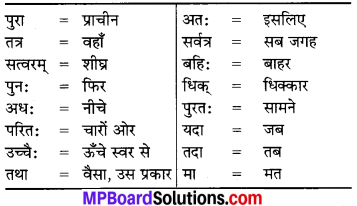
अव्यय प्रयोग (वाक्य रचना)-
- पुरा एका राज्ञी राज्यम् अकरोत्।
(प्राचीन काल में एक रानी राज्य करती थी।) - बालकाः तत्र क्षेत्रे क्रीड़न्ति।
(बालक वहाँ मैदान में खेलते हैं।) - सत्वरम् इह आगच्छः।
(यहाँ शीघ्र आओ।) - सः पुनः आगच्छति।
(वह फिर आता है।) - पृष्ठात् अधः सः पतति।
(छत से नीचे वह गिरता है।) - ग्रामम् परितः वृक्षाः सन्ति।
(गाँव के चारों ओर वृक्ष हैं।) - सा उच्चैः प्रालपत्।
(उसने ऊँचे स्वर में विलाप किया।) - सः यथा विचारयति तथा करोति।
(वह जैसा सोचता है, वैसा करता है।) - सः पठति अतः विद्यालयम् गच्छति।
(वह पढ़ता है, इसलिए विद्यालय जाता है।) - धिक् ! कापुरुषम्।
(कायर पुरुष को धिक्कार है।) - सः सर्वत्र भ्रमति।
(वह सब जगह घूमता है।) - कक्षात् बहिः गच्छ।
(कक्षा से बाहर जाओ।) - सः मम पुरतः वसति एव।
(वह मेरे सामने ही रहता है।) - यदा गरंजति तदा वर्षति।
जब गरजता है तब वर्षा होती है। - मा लिख।
(मत लिखो।)
8. प्रत्ययपरिचयः
क्त्वा प्रत्ययः-“कर” अथवा “करके” इसका अर्थ होता है।
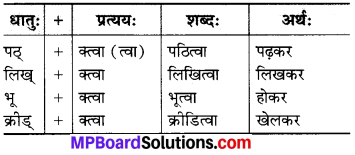
ल्यपप्रत्ययः :
“कर” अथवा “करके” के अर्थ में ल्यप होता है। ल्यप् प्रत्यय में धातु से पूर्व उपसर्ग हुआ करता है।
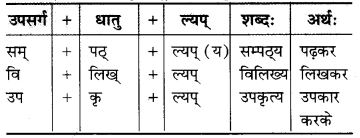
![]()
क्त, क्तवतु प्रत्ययौ- (क्त्य, क्तवतु प्रत्ययों का प्रयोग भूतकाल में होता है।)

9. उपसर्गः
(उपसर्ग धातु शब्द से पहले प्रयुक्त होकर धातु अथवा शब्द के अर्थ को बदल देता है।)
यथा-
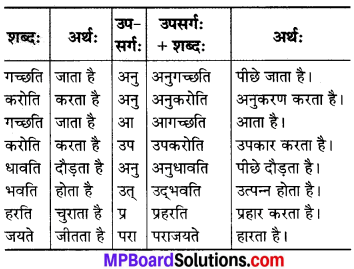
नये शब्द-प्र + गतिः= प्रगति, अनु + भवति = अनुभवति, अप + करोति = अपकरोति, उत् + खनति = उत्खनति, उत् + लिखितः = उल्लिखितः, प्र + हारः = प्रहारः, आ + हारः = आहारः इत्यादि।
10. अनुवाद के नियम
संस्कृत में अनुवाद करने के लिए मुख्य रूप से हमें विभक्ति (कारक) वचन, लिङ्ग, पुरुष, शब्द और धातु का ज्ञान होना आवश्यक है। उदाहरण के लिए-प्रथम पुरुष के एकवचन के कर्ता के साथ धातु का प्रथम पुरुष एकवचन का रूप प्रयोग होगा।
जैसे-वह जाता है-सः गच्छति।
प्रथम पुरुष :
वह दोनों जाते हैं-तौ गच्छतः।
के कर्ता :
वे सब जाते हैं-ते गच्छन्ति।
मध्यम पुरुष :
तुम जाते हो-त्वम् गच्छसि।
के कर्ता :
तुम दोनों जाते हो-युवाम् गच्छथः।
तुम सब जाते हो-यूयम् गच्छथ।
उत्तम पुरुष :
मैं जाता हूँ-अहम् गच्छामि।
![]()
के कर्ता :
हम दोनों जाते हैं-आवाम् गच्छावः।
हम सब जाते हैं-वयम् गच्छामः।
इस प्रकार शब्द और धातु के वचन व पुरुष समान होंगे। तीनों लिंग के शब्द रूप भिन्न होने पर भी धातु रूप एक ही प्रयोग किये जाते हैं। जैसे-
(1) लड़की पढ़ती है-बालिका पठति।
(2) लड़का पढ़ता है-बालकः पठति।
(3) पत्रः गिरता है-पत्रम् पतति।
संस्कृत के व्याकरण के नियमों को हम इस प्रकार जानेंगे।
पुरुष या कर्ता :
कर्ता (पुरुष) तीन प्रकार के होते हैं-प्रथम या अन्य पुरुष, मध्यम पुरुष, उत्तम पुरुष।
प्रथम या अन्य पुरुष :
जिसके सम्बन्ध में कोई बात की जाये। जैसे-वे, सीता, लड़के, वह, दोनों, वे सब आदि।
मध्यम पुरुष :
जिससे बात की जाए। जैसे-तुम, तुम दोनों, तुम सब।
उत्तम पुरुष :
जो बात करता है। जैसे-मैं, हम दोनों, हम सब।
तीनों पुरुष तीन वचनों के साथ प्रयोग होते हैं। इनका प्रयोग धातु रूपों के साथ उसी क्रम से होता है। इनके रूप इस प्रकार से चलते हैं-

![]()
इसी प्रकार से धातु रूप भी चलते हैं। यथा पठ् धातु के रूप (वर्तमान काल) में क्रमशः तीनों पुरुष के साथ बनाने पर अनुवाद इस प्रकार बनेगा-
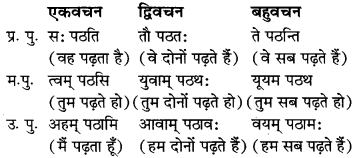
कारक, चिह्न और विभक्ति-

वर्ण परिचय :
वर्ण दो प्रकार के हैं-स्वर और व्यंजन।
स्वर :
इन्हें किसी अन्य वर्ण के सहयोग के बिना उच्चारित किया जा सकता है। ये 13 हैं-
अ, आ, इ, ई, उ, ऊ, ऋ, ए, ऐ, ओ, औ, अं और अः।
व्यंजन :
व्यंजनों का उच्चारण करने के लिए स्वरों की सहायता की आवश्यकता होती है। व्यंजन 33 हैं-
क् ख् ग् घ् ङ च् छ् ज् झ् ञ ट ठ् ड् ढ् ण् त् थ् द् ध् न् प् फ् ब् भ् म् य् र् ल् व् श् ष् स् ह्।
इनका उच्चारण करने के लिए प्रत्येक व्यंजन में ‘अ’ स्वर मिलाना पड़ता है; यथा-कमल लिखने के लिए-
क् + अ = क; म् + अ = म; ल् + अ = ल = कमल।
इसी प्रकार प्रत्येक व्यंजन में स्वर अ को मिलाकर पढ़ते हैं।
वर्ण समूह और उच्चारण स्थान :
वर्णों के उच्चारण स्थान के आधार पर उनका समूह हाता है जो निम्नलिखित है-
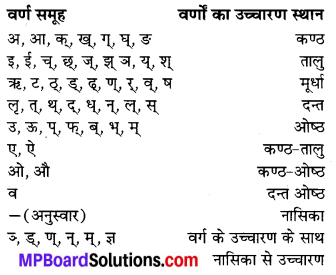
![]()
वचन :
संस्कृत में तीन वचन होते हैं-एकवचन, द्विवचन, बहुवचन।
एकवचन :
इससे किसी एक व्यक्ति अथवा वस्तु का बोध होता है। जैसे- राम, सीता, गीता आदि।
द्विवचन :
इससे दो वस्तुओं आदि का बोध होता है। जैसे-दो बालक, दो पुस्तकें, दो फल आदि।
बहुवचन :
इससे दो से अधिक वस्तुओं, स्थान या व्यक्तियों का बोध होता है। जैसे-लड़के, किताबें, स्त्रियाँ, बालिकाएँ आदि।
संस्कृत में अनुवाद बनाते समय प्रत्येक शब्द तथा धातु के साथ इन तीनों वचनों में से वाक्यानुसार किसी का भी प्रयोग होता है।
विभक्तियों का प्रयोग :
चिह्न के आधार पर वाक्य में उसी विभक्ति का प्रयोग होगा। यथा-
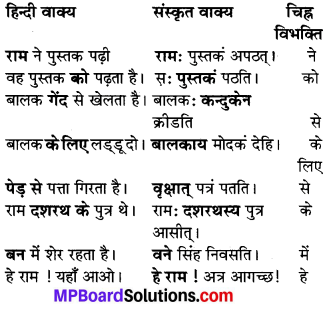
लिङ्ग :
संस्कृत में तीन लिङ्ग होते हैं-पुल्लिङ्ग, स्त्रीलिङ्ग और नपुंसकलिङ्ग।
पुल्लिङ्ग :
पुरुषवाचक शब्द पुल्लिङ्ग कहलाते हैं। जैसे-राम, मोहन, सोहन आदि।
स्त्रीलिङ्ग :
स्त्रीवाचक शब्द स्त्रीलिङ्ग कहलाते हैं। जैसे-सीता, गीता, लता, नदी, स्त्री आदि।
![]()
नपुंसकलिङ्ग :
जिन शब्दों से किन्हीं भौतिक वस्तुओं अथवा निर्जीव वस्तुओं आदि का बोध होता है। जैसे-फल, पुस्तक, कलम आदि।
(1) संस्कृत में अनुवाद कीजिए-
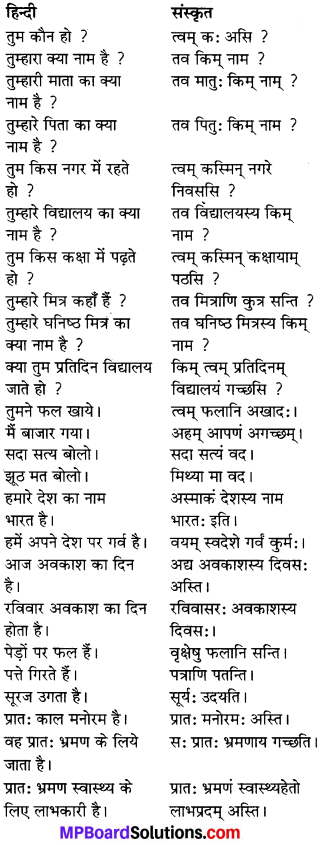
(2) संस्कृत में अनुवाद कीजिए-
- यह घोड़ा मेरा है।
एषः मम अश्वः। - चोर भ्रमित हो गया।
चौरः भ्रमितम् अभवत्। - किसान चतुर था।
कृषकः चतुरः आसीत्। - चोर ने घोड़ा चुराया था।
चौरः अश्वम् अचोरयत्। - हमारा भारत महान है।
अस्माकं भारतं महान् अस्ति। - हमारे देश का साहित्य बहुत समृद्ध है।
अस्माकं देशस्य साहित्यम् अति समृद्धम् अस्ति। - चण्डरव नाम का एक सियार था।
चण्डरवः नाम्नः एकः शृगालः आसीत्। - चण्डरव ने शोर सुना।
चण्डरवः ध्वनिं श्रुतवान्। - महान व्यक्तियों का धन सम्मान है।
महताम् जनानां धनं सम्मानम् अस्ति। - प्रवासकाल में विद्या माता के समान है।
प्रवासकाले विद्या मातृसमा अस्ति। - मेरी माता कार्य के लिए बाहर जाती हैं।
मम माता कार्याय बहिः गच्छति।
![]()
(3) संस्कृत में अनुवाद कीजिए-
- मानव जीवन के चार प्रयोजन हैं।
मानव जीवनस्य चतुः प्रयोजनानि सन्ति। - ‘निर्वाण’ मोक्ष का दूसरा नाम है।
निर्वाणं मोक्षस्य अपरं नाम अस्ति। - वीर व्यक्ति प्रयत्न से पर्वत पार करते हैं।
वीराः प्रयासेन पर्वतान् पारयन्ति। - प्रयत्न से वैभव प्राप्त करते हैं।
प्रयत्नेन वैभवं प्राप्नुवन्ति। - मयूर भारत देश का राष्ट्रीय पक्षी है।
मयूरः भारतदेशस्य राष्ट्रीय पक्षी अस्ति। - व्याघ्र पशुओं में तेजस्वी तथा पराक्रमी है।
व्याघ्रः पशुषु तेजस्वी पराक्रमी च अस्ति। - हमारी राष्ट्रभाषा हिन्दी है।
अस्माकं राष्ट्रभाषा हिन्दी अस्ति। - गाँव के लोगों का जीवन सरल होता है।
ग्रामस्य जनानां जीवनं सरलम् भवति। - गाँव के हाट में विविध दुकानें होती हैं।
ग्रामस्य हाटे विविधाः आपणाः सन्ति। - यह वीर बालक दुष्यन्त और शकुन्तला का पुत्र है।
अयं वीरः बालक : दुष्यंतस्य शकुंतलायाः च पुत्रः अस्ति।
